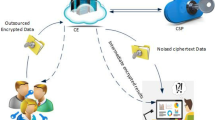Abstract
In this paper, we propose to study privacy concerns raised by the analysis of Electro CardioGram (ECG) data for arrhythmia classification. We propose a solution named PAC that combines the use of Neural Networks (NN) with secure two-party computation in order to enable an efficient NN prediction of arrhythmia without discovering the actual ECG data. To achieve a good trade-off between privacy, accuracy, and efficiency, we first build a dedicated NN model which consists of two fully connected layers and one activation layer as a square function. The solution is implemented with the ABY framework. PAC also supports classifications in batches. Experimental results show an accuracy of 96.34% which outperforms existing solutions.
Access this chapter
Tax calculation will be finalised at checkout
Purchases are for personal use only
Similar content being viewed by others
Notes
- 1.
- 2.
- 3.
- 4.
- 5.
Lectures 1&2: Introduction to Secure Computation, Yao’s and GMW Protocols, Secure Computation Course at Berkeley University.
- 6.
- 7.
References
Ball, M., Carmer, B., Malkin, T., Rosulek, M., Schimanski, N.: Garbled neural networks are practical. Cryptology ePrint Archive, Report 2019/338 (2019). https://eprint.iacr.org/2019/338
Barni, M., Failla, P., Lazzeretti, R., Sadeghi, A.R., Schneider, T.: Privacy-preserving ECG classification with branching programs and neural networks. IEEE (TIFS) (2011)
Barni, M., Orlandi, C., Piva, A.: A privacy-preserving protocol for neural-network-based computation. In: MM&Sec. ACM (2006)
Bourse, F., Minelli, M., Minihold, M., Paillier, P.: Fast homomorphic evaluation of deep discretized neural networks. In: Shacham, H., Boldyreva, A. (eds.) CRYPTO 2018. LNCS, vol. 10993, pp. 483–512. Springer, Cham (2018). https://doi.org/10.1007/978-3-319-96878-0_17
Brakerski, Z., Gentry, C., Vaikuntanathan, V.: (Leveled) fully homomorphic encryption without bootstrapping. In: ITCS (2012)
Castells, F., Laguna, P., Sörnmo, L., Bollmann, A., Roig, J.M.: Principal component analysis in ECG signal processing. EURASIP J. Adv. Signal Process. 2007(1), 1–21 (2007). https://doi.org/10.1155/2007/74580
Chabanne, H., de Wargny, A., Milgram, J., Morel, C., Prouff, E.: Privacy-preserving classification on deep neural networks (2017)
Chandran, N., Gupta, D., Rastogi, A., Sharma, R., Tripathi, S.: EzPC: programmable, efficient, and scalable secure two-party computation for machine learning. In: IEEE EuroS&P (2019)
Chou, E., Beal, J., Levy, D., Yeung, S., Haque, A., Fei-Fei, L.: Faster CryptoNets: leveraging sparsity for real-world encrypted inference (2018). http://arxiv.org/abs/1811.09953
Dahl, M., et al.: Private machine learning in tensorflow using secure computation (2018). http://arxiv.org/abs/1810.08130
Demmler, D., Schneider, T., Zohner, M.: ABY - a framework for efficient mixed-protocol secure two-party computation. In: NDSS (2015)
Dowlin, N., Gilad-Bachrach, R., Laine, K., Lauter, K., Naehrig, M., Wernsing, J.: CryptoNets: applying neural networks to encrypted data with high throughput and accuracy. In: ICML (2016)
Gentry, C.: Fully homomorphic encryption using ideal lattices. In: ACM STOC (2009)
Gentry, C.: A fully homomorphic encryption scheme (2009)
Hesamifard, E., Takabi, H., Ghasemi, M.: CryptoDL: deep neural networks over encrypted data (2017). http://arxiv.org/abs/1711.05189
Hesamifard, E., Takabi, H., Ghasemi, M., Wright, R.N.: Privacy-preserving machine learning as a service. In: PoPETs (2018)
Hunt, T., Song, C., Shokri, R., Shmatikov, V., Witchel, E.: Chiron: privacy-preserving machine learning as a service (2018). http://arxiv.org/abs/1803.05961
Ibarrondo, A., Önen, M.: FHE-compatible batch normalization for privacy preserving deep learning. In: Garcia-Alfaro, J., Herrera-Joancomartí, J., Livraga, G., Rios, R. (eds.) DPM/CBT -2018. LNCS, vol. 11025, pp. 389–404. Springer, Cham (2018). https://doi.org/10.1007/978-3-030-00305-0_27
Jiang, X., Kim, M., Lauter, K.E., Song, Y.: Secure outsourced matrix computation and application to neural networks. In: ACM CCS (2018)
Jolliffe, I.T.: Principal Component Analysis. Springer, New York (2002). https://doi.org/10.1007/b98835
Juvekar, C., Vaikuntanathan, V., Chandrakasan, A.: GAZELLE: a low latency framework for secure neural network inference. In: USENIX Security (2018)
Kass, R.E., Clancy, C.E.: Basis and Treatment of Cardiac Arrhythmias. Springer, Heidelberg (2006). https://doi.org/10.1007/3-540-29715-4
Lindell, Y.: Secure multiparty computation for privacy-preserving data mining (2008)
Liu, J., Juuti, M., Lu, Y., Asokan, N.: Oblivious neural network predictions via MiniONN transformations. In: ACM CCS (2017)
Malkhi, D., Nisan, N., Pinkas, B., Sella, Y.: Fairplay - secure two-party computation system. In: USENIX Security (2004)
Mansouri, M., Bozdemir, B., Önen, M., Ermis, O.: PAC: privacy-preserving arrhythmia classification with neural networks (2018). http://www.eurecom.fr/fr/publication/5998/download/sec-publi-5998.pdf
Mohassel, P., Zhang, Y.: SecureML: a system for scalable privacy-preserving machine learning. In: IEEE S&P (2017)
Mohassel, P., Rindal, P.: Aby\(^{3}\): a mixed protocol framework for machine learning. In: ACM CCS (2018)
Ohrimenko, O., Schuster, F., Fournet, C., Mehta, A., Nowozin, S., Vaswani, K., Costa, M.: Oblivious multi-party machine learning on trusted processors. In: USENIX Security (2016)
Orlandi, C., Piva, A., Barni, M.: Oblivious neural network computing via homomorphic encryption. EURASIP 2007, 037343 (2007)
Paillier, P.: Public-key cryptosystems based on composite degree residuosity classes. In: Stern, J. (ed.) EUROCRYPT 1999. LNCS, vol. 1592, pp. 223–238. Springer, Heidelberg (1999). https://doi.org/10.1007/3-540-48910-X_16
Riazi, M.S., Weinert, C., Tkachenko, O., Songhori, E.M., Schneider, T., Koushanfar, F.: Chameleon: a hybrid secure computation framework for machine learning applications. In: AsiaCCS (2018)
Rouhani, B.D., Riazi, M.S., Koushanfar, F.: DeepSecure: scalable provably-secure deep learning. In: DAC (2018)
Sanyal, A., Kusner, M.J., Gascón, A., Kanade, V.: TAPAS: tricks to accelerate (encrypted) prediction as a service (2018). http://arxiv.org/abs/1806.03461
Tramèr, F., Boneh, D.: Slalom: fast, verifiable and private execution of neural networks in trusted hardware. In: ICLR (2019)
Wagh, S., Gupta, D., Chandran, N.: SecureNN: efficient and private neural network training. In: PETS (2019)
Acknowledgments
This work was partly supported by the PAPAYA project funded by the European Union’s Horizon 2020 Research and Innovation Programme, under Grant Agreement no. 786767.
Author information
Authors and Affiliations
Corresponding author
Editor information
Editors and Affiliations
Rights and permissions
Copyright information
© 2020 Springer Nature Switzerland AG
About this paper
Cite this paper
Mansouri, M., Bozdemir, B., Önen, M., Ermis, O. (2020). PAC: Privacy-Preserving Arrhythmia Classification with Neural Networks. In: Benzekri, A., Barbeau, M., Gong, G., Laborde, R., Garcia-Alfaro, J. (eds) Foundations and Practice of Security. FPS 2019. Lecture Notes in Computer Science(), vol 12056. Springer, Cham. https://doi.org/10.1007/978-3-030-45371-8_1
Download citation
DOI: https://doi.org/10.1007/978-3-030-45371-8_1
Published:
Publisher Name: Springer, Cham
Print ISBN: 978-3-030-45370-1
Online ISBN: 978-3-030-45371-8
eBook Packages: Computer ScienceComputer Science (R0)




